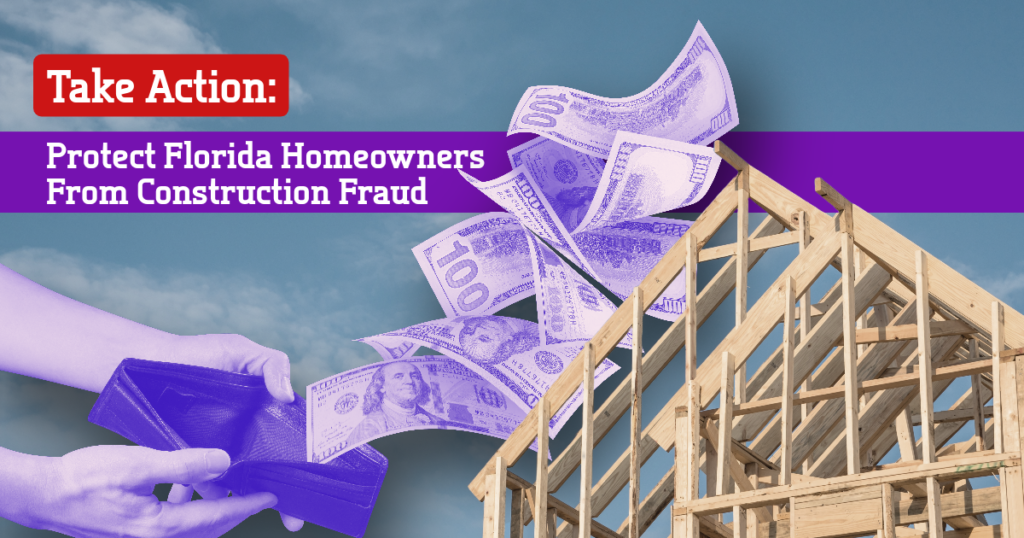
In Florida’s ever-evolving home construction scene, state legislators have struggled with how to combat construction fraud effectively. Seeking to provide financial protection for homeowners, legislators established the Homeowners Construction Recovery Fund (HCRF). Initiated in 1993, this fund has been a lifeline for those defrauded by licensed contractors. Recent data reveals a troubling increase in Florida homeowners falling victim to contractor fraud, emphasizing the critical need to strengthen the HCRF. The last time legislators tweaked the fund was in 2016, and the aggregate cap homeowners can recover from licensed contractors was set in 2004. With escalating construction costs, it’s imperative to modernize the fund to prevent homeowners from facing financial ruin. That is why Floridians For Honest Lending supports Senate Bill 414, which, if passed, would modernize the fund’s payout caps and align them with current costs, shielding homeowners from the dire consequences of fraud-induced bankruptcy and foreclosure.
The recent rise in claims is troublesome
The Florida Department of Business and Professional Regulation oversees the Homeowners Construction Recovery Fund, which, in fiscal year 2021-2022, awarded 141 claims totaling $2,736,747. The escalating number of claims in the first 5 months of 2022-2023, totaling $2,017,763, signals a growing trend of construction-related problems, placing more Florida homeowners in financial jeopardy.
How does the fund operate?
Florida categorizes contractors into Division 1 and Division 2, each with different caps on recovery amounts. The graph below illustrates the historical changes in caps and how Senate Bill 414 proposes increments to align with current and future cost increases.
Current funding caps of the Homeowners Construction Recovery Fund:
Year of Change |
Division I Single Claimant Cap |
Division II Single Claimant Cap |
Division I Aggregate Cap (per contractor) |
Division II Aggregate Cap (per contractor) |
| 1993 | Up to $25,000 | Up to $25,000 | $50,000 | $50,000 |
| 1996 | Up to $25,000 | Up to $25,000 | $100,000 | $100,000 (Increase in aggregate cap) |
| 1998 | Up to $25,000 | Up to $25,000 | $100,000 annually. $250,000 lifetime | $100,000 annually. $250,000 lifetime (Approved payouts exceeding the annual cap can be funded the following year.) |
| 2004 | Up to $50,000 | x | $500,000 | x (Division II contractors removed. No payout for court costs, attorney fees, medical bills, or interest.) |
| 2016 | Up to $25,000 | Up to $15,000 | $500,000 | $150,000 (Caps on recovery based on actual damages.) |
Proposed Changes in Senate Bill 414:
Year of Change |
Division I Single Claimant Cap |
Division II Single Claimant Cap |
Division I Aggregate Cap (per contractor) |
Division II Aggregate Cap (per contractor) |
| 2024 | $75,000 | $25,000 | $700,000 | $250,000 |
| 2025 | $125,000 | $35,000 | $800,000 | $350,000 |
| 2026 | $175,000 | $45,000 | $900,000 | $450,000 |
| 2027 | $250,000 | $65,000 | $1,000,000 | $550,000 |
The Harsh Reality: Florida Homeowners Continue to Face Fraudulent Practices
Regrettably, headlines across Florida abound with cases of contractor fraud. In a historic scam, Miami real estate developer Doug Cox faces allegations of fraud, leaving numerous buyers and investors on the hook for over $72 million. Cox is accused of reneging on promises to build multiple houses, with real estate contracts valued between $1.2 million and $1.8 million. The inadequacy of the current $500,000 aggregate cap on the Homeowner Construction Recovery Fund becomes glaring, as it would cover only one claimant.
In another high-profile case, a Florida pool contractor has been sentenced to 30 years for orchestrating a fraudulent pool contracting scheme, swindling millions from unsuspecting clients. Brian Washburn faced charges of orchestrating a scheme to defraud and two counts of money laundering exceeding $100,000. The current individual claim cap of $15,000 and aggregate cap of $150,000 prove insufficient for the numerous victims.
Florida homeowners find themselves entangled in legal and financial woes long after contracting with unscrupulous builders. Instances like the alleged scam by Nationwide Roofing, where a contractor vanished after taking down payments for stalled home renovations, exemplify the urgent need for increased fund caps.
The Case for Enhancing Fund Caps:
Florida must raise the caps on the Homeowners Construction Recovery Fund, and Senate Bill 414 provides a viable solution. Beyond modernizing fund caps, it’s about aligning priorities to ensure fair resolutions and a financial safety net for Florida homeowners, preventing them from facing the dire consequences of bankruptcy and foreclosure.
For additional information on the Homeowners Construction Recovery Fund, please refer to the Department of Business and Professional Regulation’s Frequently Asked Questions page.
Write your lawmakers: Urge them to increase protections for homeowners facing construction fraud

Write your Florida lawmakers to support Senate Bill 414 to ensure a better financial safety net for Florida homeowners facing contractor fraud. By modernizing the HCRF, we can protect residents from the worst consequences of bankruptcy and foreclosure resulting from construction fraud.
